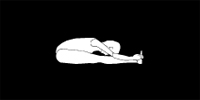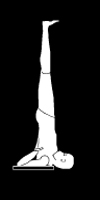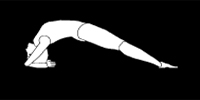INTRODUCTION
Appendicitis refers to the inflammation of the appendix. The appendix is an outpouching from the caecum (a portion of the large intestine). Appendicitis is the most common surgical emergency of the abdomen. It affects about 10% of the population. The incidence of appendicitis is about 1 in 500 persons every year. The condition affects all ages but is uncommon in children below two years.

YOGA AND APPENDICITS
Yoga is primarily a philosophical science, born out of man's need to fathom the meaning of existence. Patanjali, the father of yoga, states in the second sutra "Yoga is the cessation of consciousness." The ultimate aim of yoga is self-evolution. In ancient times, when people lived the yogic way, good health was the natural result of their lifestyle. But, as health deteriorated with man's changing values, yoga gained ground in its use as therapy. Yoga uses postures to correct inner malfunction according to natural principles. It is important to minimize the use of drugs whenever possible and employ natural methods that, in the long run, preserve the sensitivity of the body. Such a body will be more responsive to treatment than one that has been constantly exposed to drugs.

YOGA POSES FOR APPENDICITIS
Triangle Pose
Energy in the spine increases. It stimulates blood flow and helps to stretch and relax the back, shoulders, legs and arms as well as increases the flow of blood to the head. The muscles of the thighs and calves as well as the hamstrings are stretched. The slight twist of the spine creates suppleness in the spinal discs and relieves lower back discomforts.
Supported Head Stand Pose
This posture helps to strengthen your sense of balance and concentration. The arch formed by the back and stretched leg gently aligns the vertebrae of the spine restoring suppleness and easing strain caused by poor posture or long periods of sitting. It tones the muscles of the hips and legs as well as stimulates the chest muscles.
Warrior Pose
Warrior III improves balance, memory and concentration, and tones and invigorates the whole body. This pose improves circulation and respiration and energizes the entire body. It improves balance and concentration; builds confidence.
YOGA ASANAS FOR APPENDICITIS

VRIKSHASANA
Vrikshasana is an asana or pose that is excellent for any yoga routine intended for the improvement of flexibility and balance.
Steps
• Inhale and exhale take both your arms up above your head from the sides and join your palms above the head.
• Lift your heels, stand on your toes and pull your whole body upwards, keeping more weight on the left foot
• Continue breathing normally.
• Use your right hand to lift up the left foot and bring it to rest on the right leg; sole of the foot resting on the right inner thigh.
• Stretch your hands as far up as possible. The more your body is stretched, the easier it is to maintain the balance.
• Keep your sight and mind fixed on an object in front.
• Releasing, exhale and bring both your hands down from the sides.
• Simultaneously, bring your heels to the floor in a normal standing position.
PASCHIMOTTANASANA

Paschimottanasana is a fine stretching exercise of the body. In one continuous movement, almost all the posterior muscles get fully stretched and relaxed.
This helps to improve the functions of the abdominal organs and sets right respiratory disorders. It also helps to improve memory.
Steps
• This posture involves stretching of the posterior muscles of the body.
• While sitting, stretch your legs forward and keep them close to each other. Bend a little forward, make hooks of your fingers and hold the big toes on the respective sides.
• While exhaling, bend forward stretching the trunk along the thighs. Rest your on the knees, which should be kept straight.
• Gradually, the tense muscles can be made supple for securing the complete posture. Inhale and return to the original position.
SARVANGASANA

The Shoulder Stand is one of the best yoga asanas or poses that you can practice to stimulate and rejuvenate your entire body.
Steps
• Lie flat on your back
• Place your hands by your sides, palms down, and begin to raise your legs.
• Press your hands against the floor to push your legs up to a 90° angle.
• Now place your hands on your hips, elbows on the ground.
• Try to straighten your legs and hold them upward.
• Next roll your palms down your back as low down as you can.
• Try to keep your body upright in an inverted position. Your chin should be tucked into the pit of your throat.
• Close your eyes and relax. Hold the pose for as long as possible.
• To come out of the posture, bend your legs towards your head, then slowly release your hands, and roll back into a supine position, one vertebra at a time.
• Avoid raising your head when lying down at the end.
SHASHANKASANA

This asana strengthens the muscles of the legs and thighs and makes them supple. It tones up the spinal nerves and helps in relieving arthritic pain. It is an excellent asana for digestion.
Steps
• Sit with legs folded backwards, heels apart, knees and toes together.
• Adjust your hips between the heels (Vajrasana). Slowly raise your arms over the head.
• While exhaling, slowly bend forward and stretch your palms on the floor with abdomen pressing against the thighs.
• Then bring your face downwards and touch the floor with the forehead without raising the buttocks. Inhaling slowly, return to an upright position, reversing the process.
MATSYASANA

This asana is very useful for persons suffering from chronic cough, bronchial asthma, congestion, infected tonsils and other respiratory disorders. Problems relating to thyroid and para-thyroid glands can also be overcome be done to derive the full of Sarvangasana.it is recommended that you breath while holding it for between two and four minutes.
Steps
• Sit with your legs fully stretched out. Bend each leg at the knees and place your feet on the other hip joint. Both the heels are adjusted in such a way that each presses the adjacent portion of the abdomen. This forms the foot-lock in a sitting position.
• Bend backwards and, exhaling, rest your weight on the elbows. Push your neck backwards and slightly rise the hip upward thus making an arch of the spine.
• Then, by making hooks of the forefingers, hold your toes on the corresponding side without crossing your arms.This posture should be maintained for some time with slow and deep breathing.
• For reverting to the original position, release the foot-lock and return to the supine position by lowering the arch.
ASTROLOGY
Yoga Sutra which is the ancient text dwelling on all traditional yoga basic, defines the sand script term of asana as something comfortable and easy but firm. Yoga asanas can be interpreted as common yoga positions which allow the practitioners to be perfectly balanced between activity and non-activity. Asanas description applies that at the time of exercising, the practitioners are, as yoga authorities put it, being doing, and being done by the yoga positions. A unique characteristic of Indian astrology are the yoga's. Yoga's are planetary positions that lead to a certain result. Yoga is a term for good fortune and unless specified otherwise, yoga is a good yoga. Yoga is a particular placement or combination of planets, which collectively raise the fortunes of a person, which cannot be deciphered by individual study of placement of participating planet. According to astrological reports for yoga asanas the above mentioned asanas are said to be effective for those who come under the following zodiac sign
• CANCER
• LIBRA